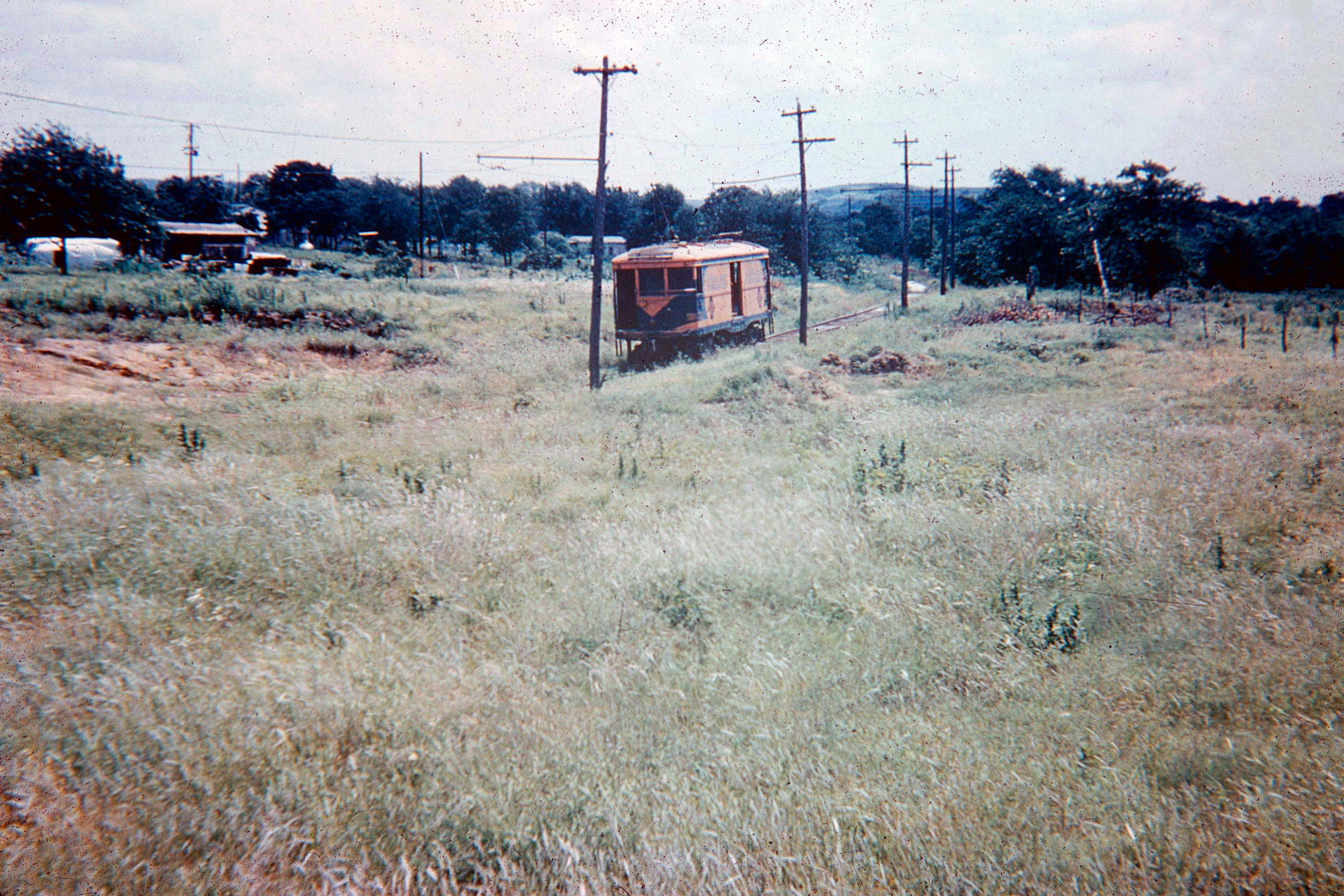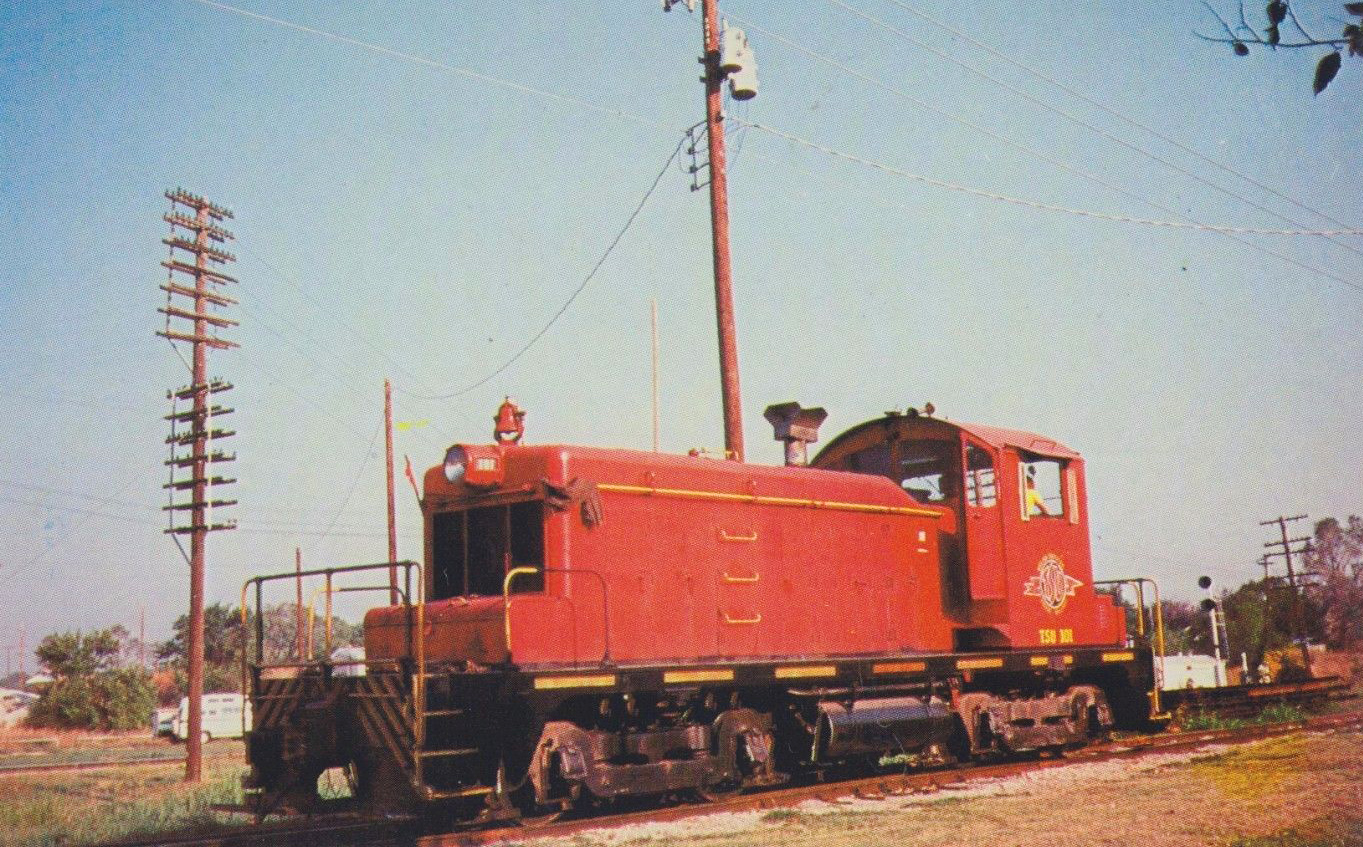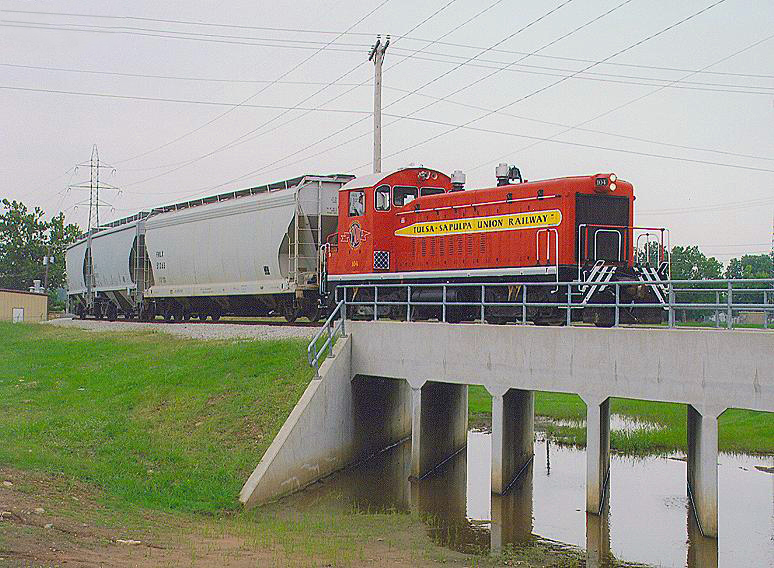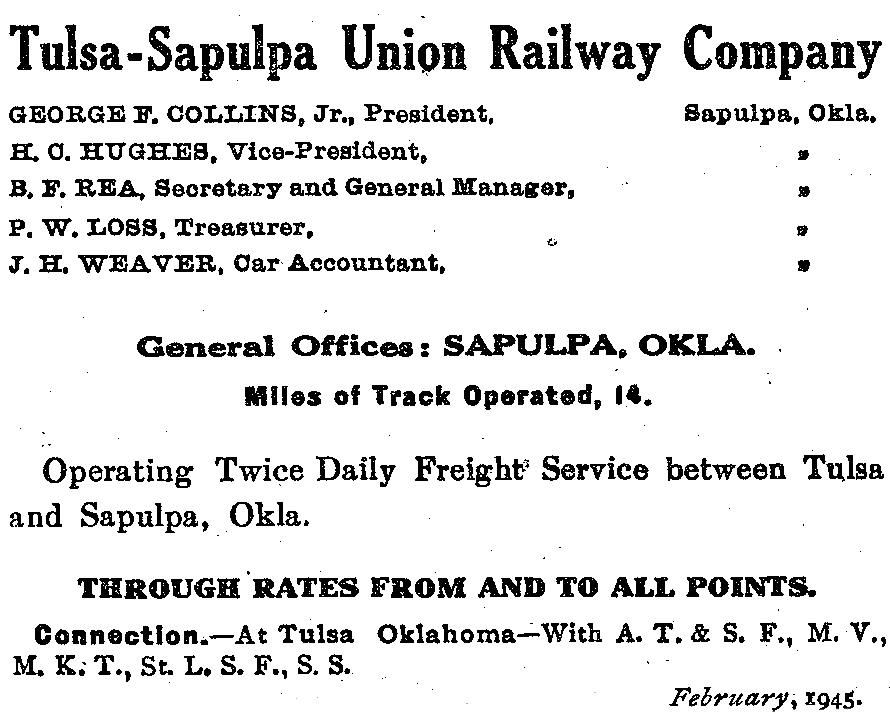Tulsa-Sapulpa Union Railway: An Ex-Interurban Line
Last revised: September 2, 2024
By: Adam Burns
The Tulsa-Sapulpa Union Railway (reporting marks, TSU) history dates back to Oklahoma's
earliest history as a state.
Originally the line was conceived as an interurban and operated under a different name and has only been known as the TSU since World War II.
As with virtually all interurbans the two primary lines that made up what would become the TSU were unsuccessful in their first attempts; one to serve the town of Tulsa and the other the town of Sapulpa to the south.
After merging and purchasing a third interurban they had somewhat more successful. Unfortunately, it took an additional bankruptcy until the line found its footing, which didn't occur until World War II thanks in large part to an interchange with two Class Is at Tulsa.
Since that the railroad has sustained itself through a steady diet of local freight traffic and continued interchange with two Class Is despite the fact that it operates only a portion of its original main line.
 Tulsa-Sapulpa Union Railway car #202 is somewhere along the main line between Tulsa and Sapulpa in the summer of 1957. The electrification would survive for another three years. Author's collection.
Tulsa-Sapulpa Union Railway car #202 is somewhere along the main line between Tulsa and Sapulpa in the summer of 1957. The electrification would survive for another three years. Author's collection.The Tulsa-Sapulpa Union Railway's history begins in 1907 when the small Sapulpa & Interurban Railway was chartered to serve its namesake town with local nearby communities.
The S&I was conceived during what is widely considered the second major interurban construction period between 1905 and 1908.
The line was, like many of its kind, chartered to serve an area that was only lightly populated and chances of success were slim, even for passenger traffic (of course, the euphoria of the industry and its potential somewhat clouded financiers and visionaries at the time).
A year later, in 1908 the Sapulpa & Interurban opened a route connecting to Kiefer, Glenpool, and Mounds. As mentioned above, with little online freight or passenger traffic the new interurban quickly hit hard times and was on the brink the collapse.
However, thanks to a booming oil industry that hit just a few years after it opened folks and business began flocking to the region.
Unfortunately, the S&I still fell into bankruptcy in 1912 and was merged with a neighboring line to the north, the Oklahoma Union Railway to hopefully improve both companies' fortunes.
The Oklahoma Union served Tulsa as well as communities to the southwest and had attempted to reach Sapulpa although funding and lack of traffic precluded it from finishing the line.
Through the merger the Oklahoma Union name was retained although a second bankruptcy in 1917 saw it again reorganized as the Sapulpa Electric Interurban Railway.
A year later under this name the company completed the connection between Sapulpa and Tulsa, in 1918, giving it a total route of 25 miles.
Interestingly, around the same time via an affiliation with three small main line railroads which it connected to the OU hoped to connect much of central Oklahoma. As with most interurban hopes, however, these grand plans never came close to being realized.
In 1929 the line was again in bankruptcy, due in no small part to the Great Depression which hit that year.
In 1935 it was reorganized as the Sapulpa Union Railway thanks to a new owner by the name of George F. Collins.
It was around this time that the line's fortunes began to improve as it focused more heavily on freight and moved away from passenger services, which ended in 1933.
Up through that time the Sapulpa Union had been using a combination of interurban cars, box motors, and steeple cabs for both freight and passenger operations.
With the discontinuance of the latter the company began mostly operating its B-B steeple cabs. In 1943 the line was renamed into its current form, the Tulsa-Sapulpa Union Railway and continued to concentrate of freight services with connections to:
- Texas & Pacific (a Missouri Pacific subsidiary)
- Missouri-Kansas-Texas (Katy)
- Santa Fe
- Fellow interurban Sand Springs Railway at Tulsa
- Frisco (St. Louis-San Francisco Railway) at Sapulpa
 A postcard of Tulsas-Sapulpa Union SW1 #101, built as Wabash Railroad #105 in 1940 by Electro-Motive.
A postcard of Tulsas-Sapulpa Union SW1 #101, built as Wabash Railroad #105 in 1940 by Electro-Motive.The electric motors remained in use until 1960 when the short line replaced these with Electro-Motive diesel switchers such as SW1s and SW7s.
At that time the railroad was deriving profits from its freight service of around $100,000 annually. The line to Mounds was eventually abandoned leaving only the original Tulsa-Sapulpa route in place and by 1970 the company operated a 10-mile system, which is still the case today.
Also of importance to the line's sustainability through the years has been its connection to Class Is. Even today it still retains these connections, with Union Pacific at Tulsa and the BNSF Railway at Sapulpa.
Perhaps most interesting is the fact that it still connects with the Sand Springs at Tulsa, which like the TSU is one of the few former interurbans to survive as a short line.
Locomotive Roster
| Builder | Model Type | Road Number | Built | Quantity |
|---|---|---|---|---|
| EMD | SW1 | 101-102 | 1940, 1947, Ex-Wabash | 2 |
| EMD | SW9 | 104 | 1952, Ex-Burlington Northern | 1 |
| EMD | SW7 | 107 | 1950, Ex-Burlington Northern | 1 |
| EMD | SW1200 | 108 | 1962, Ex-Soo Line | 1 |
 The same train as pictured in the top photo has just completed its interchange with Union Pacific at Garden City, Oklahoma and heads home to Sapulpa. Doug Kroll photo.
The same train as pictured in the top photo has just completed its interchange with Union Pacific at Garden City, Oklahoma and heads home to Sapulpa. Doug Kroll photo.This connection makes the two companies perhaps the only former interurbans still in operation that retain interchanges with one another.
Aside from the Tulsa-Sapulpa Union Railway's current Class I interchanges its traffic base today includes sand, plastics, petroleum products (a source of freight that has long sustained the line), food-based products, and others.
Additionally, the company leases from Union Pacific a branch between Tulsa and Jenks (a former T&P line), stretching 13 miles and giving it a total operation of 23 miles. To learn more about the Tulsa-Sapulpa Union Railway please click here to visit their website.
Recent Articles
-
Maryland's - Wine Tasting - Train Rides
Jan 15, 26 02:59 PM
This article delves into the enchanting world of wine tasting train experiences in Maryland, providing a detailed exploration of their offerings, history, and allure. -
Colorado's - Wine Tasting - Train Rides
Jan 15, 26 02:46 PM
To truly savor these local flavors while soaking in the scenic beauty of Colorado, the concept of wine tasting trains has emerged, offering both locals and tourists a luxurious and immersive indulgenc… -
Iowa ~ Wine Tasting ~ Train Rides
Jan 15, 26 02:36 PM
The state not only boasts a burgeoning wine industry but also offers unique experiences such as wine by rail aboard the Boone & Scenic Valley Railroad. -
Georgia's Wine Train Rides In Cordele!
Jan 15, 26 02:26 PM
While the railroad offers a range of themed trips throughout the year, one of its most crowd-pleasing special events is the Wine & Cheese Train—a short, scenic round trip designed to feel like a t… -
Indiana ~ Murder Mystery ~ Dinner Train Rides
Jan 15, 26 02:22 PM
This piece explores the allure of murder mystery trains and why they are becoming a must-try experience for enthusiasts and casual travelers alike. -
Ohio ~ Murder Mystery ~ Dinner Train Rides
Jan 15, 26 02:10 PM
The murder mystery dinner train rides in Ohio provide an immersive experience that combines fine dining, an engaging narrative, and the beauty of Ohio's landscapes. -
Nevada Dinner Train Rides In Ely!
Jan 15, 26 02:01 PM
If you’ve ever wished you could step through a time portal into the hard-working world of a 1900s short line the Nevada Northern Railway in Ely is about as close as it gets. -
Michigan Dinner Train Rides In Owosso!
Jan 15, 26 09:46 AM
The Steam Railroading Institute is best known as the home of Pere Marquette #1225 and even occasionally hosts a dinner train! -
Arizona's - Wine Tasting - Train Rides
Jan 14, 26 02:04 PM
For those who want to experience the charm of Arizona's wine scene while embracing the romance of rail travel, wine tasting train rides offer a memorable journey through the state's picturesque landsc… -
Arkansas's - Wine Tasting - Train Rides
Jan 14, 26 01:57 PM
This article takes you through the experience of wine tasting train rides in Arkansas, highlighting their offerings, routes, and the delightful blend of history, scenery, and flavor that makes them so… -
Tennessee ~ Murder Mystery ~ Dinner Train Rides
Jan 14, 26 01:42 PM
Amidst the rolling hills and scenic landscapes of Tennessee, an exhilarating and interactive experience awaits those with a taste for mystery and intrigue. -
California ~ Murder Mystery ~ Dinner Train Rides
Jan 14, 26 01:26 PM
When it comes to experiencing the allure of crime-solving sprinkled with delicious dining, California's murder mystery dinner train rides have carved a niche for themselves among both locals and touri… -
Illinois ~ Murder Mystery ~ Dinner Train Rides
Jan 14, 26 01:13 PM
Among Illinois's scenic train rides, one of the most unique and captivating experiences is the murder mystery excursion. -
Vermont's - Murder Mystery - Dinner Train Rides
Jan 14, 26 12:57 PM
There are currently murder mystery dinner trains offered in Vermont but until recently the Champlain Valley Dinner Train offered such a trip! -
Massachusetts Dinner Train Rides On Cape Cod!
Jan 14, 26 12:20 PM
The Cape Cod Central Railroad (CCCR) has carved out a special niche by pairing classic New England scenery with old-school hospitality, including some of the best-known dining train experiences in the… -
Maine Dinner Train Rides In Portland!
Jan 14, 26 11:31 AM
While this isn’t generally a “dinner train” railroad in the traditional sense—no multi-course meal served en route—Maine Narrow Gauge does offer several popular ride experiences where food and drink a… -
Kentucky Dinner Train Rides In Bardstown!
Jan 13, 26 01:14 PM
The essence of My Old Kentucky Dinner Train is part restaurant, part scenic excursion, and part living piece of Kentucky rail history. -
Kansas Dinner Train Rides In Abilene!
Jan 13, 26 12:44 PM
If you’re looking for a heritage railroad that feels authentically Kansas—equal parts prairie scenery, small-town history, and hands-on railroading—the Abilene & Smoky Valley Railroad (A&SV) delivers. -
Michigan ~ Murder Mystery ~ Dinner Train Rides
Jan 13, 26 11:24 AM
Among the lesser-known treasures of this state are the intriguing murder mystery dinner train rides—a perfect blend of suspense, dining, and scenic exploration. -
Virginia's - Murder Mystery - Dinner Train Rides
Jan 13, 26 11:11 AM
Among the state's railroad attractions, murder mystery dinner trains stand out as a captivating fusion of theatrical entertainment, fine dining, and scenic travel. -
Arizona Dinner Train Rides At The Grand Canyon!
Jan 13, 26 10:59 AM
While the Grand Canyon Railway does not offer a true, onboard dinner train experience it does offer several upscale options and off-train dining. -
Georgia Dinner Train Rides In Nashville!
Jan 13, 26 10:27 AM
If you’ve ever wished you could slow down, trade traffic for jointed rail, and let a small-town landscape roll by your window while a hot meal is served at your table, the Azalea Sprinter delivers tha… -
Indiana Valentine's Train Rides
Jan 12, 26 04:27 PM
If you’ve ever wished you could step into a time when passenger trains were a Saturday-night treat and a whistle echoing across farm fields meant “adventure,” the Nickel Plate Express delivers that fe… -
Ohio Valentine's Train Rides!
Jan 12, 26 04:20 PM
The Hocking Valley Scenic Railway offers one of the region’s most atmospheric ways to experience the Hocking Hills area: from the rhythmic click of jointed rail to the glow of vintage coaches rolling… -
Wisconsin's - Wine Tasting - Train Rides
Jan 12, 26 03:10 PM
Wisconsin might not be the first state that comes to mind when one thinks of wine, but this scenic region is increasingly gaining recognition for its unique offerings in viticulture. -
California's - Wine Tasting - Train Rides
Jan 12, 26 02:34 PM
This article explores the charm, routes, and offerings of these unique wine tasting trains that traverse California’s picturesque landscapes. -
Wisconsin Scenic Train Rides In North Freedom!
Jan 12, 26 02:20 PM
The Mid-Continent Railway Museum is a living-history museum built around the sights, sounds, and everyday rhythms of small-town and shortline railroading in the early 20th century, what the museum cal… -
Vermont Scenic Train Rides In Burlington!
Jan 12, 26 01:18 PM
Today, GMRC is best known by many travelers for its Burlington-based passenger experiences—most famously the Champlain Valley Dinner Train and the sleek, limited-capacity Cocktails on the Rails. -
Maryland's - Murder Mystery - Dinner Train Rides
Jan 12, 26 01:03 PM
Maryland is known for its scenic landscapes, historical landmarks, and vibrant culture, but did you know that it’s also home to some of the most thrilling murder mystery dinner trains? -
Minnesota's - Murder Mystery - Dinner Train Rides
Jan 12, 26 12:17 PM
Murder mystery dinner trains offer an enticing blend of suspense, culinary delight, and perpetual motion, where passengers become both detectives and dining companions on an unforgettable journey. -
Vermont Dinner Train Rides In Burlington!
Jan 12, 26 12:09 PM
There is one location in Vermont hosting a dedicated dinner train experience at the Green Mountain Railroad. -
Connecticut Dinner Train Rides In Essex!
Jan 12, 26 10:39 AM
Connecticut's rail heritage can be traced back to the industry's earliest days and a few organizations preserve this rich history by offering train rides. The Essex Steam Train also hosts dinner-theme… -
Florida Scenic Train Rides In Parrish!
Jan 11, 26 10:26 PM
The Florida Railroad Museum (FRRM) in Parrish offers something increasingly rare in today’s rail landscape: a chance to ride historic equipment over a surviving fragment of an early-20th-century mainl… -
California's - Wine Tasting - Train Rides
Jan 11, 26 02:28 PM
This article explores the charm, routes, and offerings of these unique wine tasting trains that traverse California’s picturesque landscapes. -
Georgia's - Murder Mystery - Dinner Train Rides
Jan 11, 26 02:07 PM
In the heart of the Peach State, a unique form of entertainment combines the thrill of a murder mystery with the charm of a historic train ride. -
Colorado ~ Murder Mystery ~ Dinner Train Rides
Jan 11, 26 01:43 PM
Nestled among the breathtaking vistas and rugged terrains of Colorado lies a unique fusion of theater, gastronomy, and travel—a murder mystery dinner train ride. -
Minnesota Dinner Train Rides In Duluth!
Jan 11, 26 01:32 PM
One of the best ways to feel the region's history in motion today is aboard the North Shore Scenic Railroad (NSSR), which operates out of Duluth’s historic depot. -
Illinois Dinner Train Rides At Monticello!
Jan 11, 26 12:42 PM
The Monticello Railway Museum (MRM) is one of those places that quietly does a lot: it preserves a sizable collection, maintains its own operating railroad, and—most importantly for visitors—puts hist… -
Alabama's - Wine Tasting - Train Rides
Jan 10, 26 09:29 AM
While the state might not be the first to come to mind when one thinks of wine or train travel, the unique concept of wine tasting trains adds a refreshing twist to the Alabama tourism scene. -
Maryland Dinner Train Rides At WMSR!
Jan 10, 26 09:13 AM
The Western Maryland Scenic Railroad (WMSR) has become one of the Mid-Atlantic’s signature heritage operations—equal parts mountain railroad, living museum, and “special-occasion” night out. -
Arkansas Dinner Train Rides On The A&M!
Jan 10, 26 09:11 AM
If you want a railroad experience that feels equal parts “working short line” and “time machine,” the Arkansas & Missouri Railroad (A&M) delivers in a way few modern operations can. -
South Dakota's - Murder Mystery - Dinner Train Rides
Jan 10, 26 09:08 AM
While the state currently does not offer any murder mystery dinner train rides, the popular "1880 Train" at the Black Hills Central recently hosted these popular trips! -
Wisconsin's - Murder Mystery - Dinner Train Rides
Jan 10, 26 09:07 AM
Whether you're a fan of mystery novels or simply relish a night of theatrical entertainment, Wisconsin's murder mystery dinner trains promise an unforgettable adventure. -
Missouri's - Murder Mystery - Dinner Train Rides
Jan 10, 26 09:05 AM
Missouri, with its rich history and scenic landscapes, is home to one location hosting these unique excursion experiences. -
Washington ~ Murder Mystery ~ Dinner Train Rides
Jan 10, 26 09:04 AM
This article delves into what makes murder mystery dinner train rides in Washington State such a captivating experience. -
Kentucky Scenic Train Rides At KRM!
Jan 09, 26 11:13 PM
Located in the small town of New Haven the Kentucky Railway Museum offers a combination of historic equipment and popular excursions. -
Washington "Wine Tasting" Train Rides
Jan 09, 26 08:53 PM
Here’s a detailed look at where and how to ride, what to expect, and practical tips to make the most of wine tasting by rail in Washington. -
Kentucky's - Wine Tasting - Train Rides
Jan 09, 26 08:21 PM
Kentucky, often celebrated for its rolling pastures, thoroughbred horses, and bourbon legacy, has been cultivating another gem in its storied landscapes; enjoying wine by rail. -
Kentucky's - Murder Mystery - Dinner Train Rides
Jan 09, 26 01:12 PM
In the realm of unique travel experiences, Kentucky offers an enchanting twist that entices both locals and tourists alike: murder mystery dinner train rides. -
Utah's - Murder Mystery - Dinner Train Rides
Jan 09, 26 01:05 PM
This article highlights the murder mystery dinner trains currently avaliable in the state of Utah!


















































